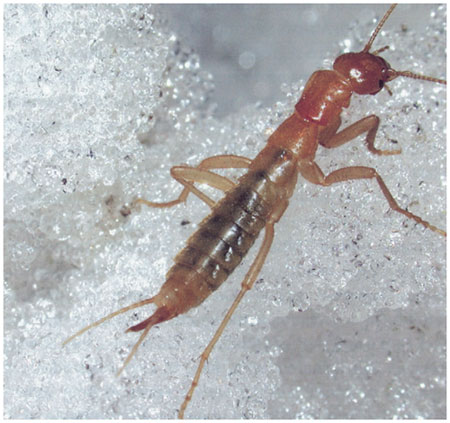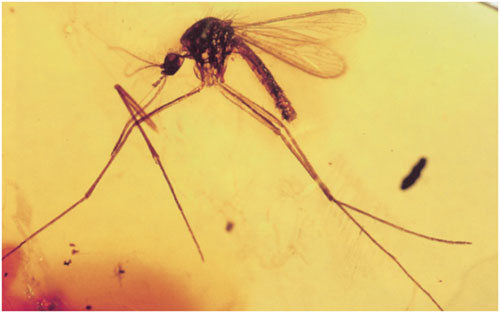
This Article From Issue
July-August 2006
Volume 94, Number 4
Page 376
DOI: 10.1511/2006.60.376
Evolution of the Insects. David Grimaldi and Michael S. Engel. xvi + 755 pp. Cambridge University Press, 2005. $80.
History of Insects. Edited by Alexandr P. Rasnitsyn and Donald L. J. Quicke. xii + 517 pp. Kluwer Academic Publishers, 2002. $359.
The humble beginnings and evolution of insects are wrapped in a shroud of mystery and controversy, owing in part to their great diversity. Because many of the crucial fossils that could answer significant questions are fragmentary or are of doubtful age, some people might claim that their designation is more a philosophical exercise than a scientific study. Indeed, one paleoentomologist—Robin John Tillyard (1881-1937)—is reported to have taken his specimens to a clairvoyant in hopes of receiving some message about their true nature. Although fossil insects have been collected and studied for some time, a comparison of two recent books dealing with their appearance, phylogeny and status makes it obvious that opinions still vary as to just what begat what.

From Evolution of the Insects.
Evolution of the Insects (2005), by David Grimaldi and Michael S. Engel, and History of Insects (2002), edited by Alexandr Rasnitsyn and Donald Quicke, contain facts about fossil insects that will be useful to general biologists. However, both works will be appreciated chiefly by systematists attempting to decipher the evolutionary pathways of a given insect group and by fossil collectors endeavoring to identify specimens. Each of the books presents a synthesis of phylogeny, biogeography, ecology and the fossil record, supporting the presentation with a wide selection of detailed photographs and drawings. Evolution of the Insects is filled with lavish color photographs of both fossil and recent insects, thanks to a generous donation that defrayed publication costs. However, it remains a puzzle why Grimaldi and Engel selected particular photos of modern insects, because many seem to have no direct bearing on evolution. Their book's most striking portrayals of insects in Dominican amber come from a private collection in Italy, making the point that individual collectors can assist scientists by loaning their specimens for study.
Dealing with such a complex subject is an arduous task. Grimaldi (Curator of Invertebrate Zoology at the American Museum of Natural History) and Engel (a paleoentomologist at the University of Kansas) take on the challenge themselves, but Rasnitsyn (a professor at the Paleontological Institute, Russian Academy of Sciences, Moscow) and Quicke (reader in systematics, Division of Biology, Imperial College London) enlist the assistance of 21 well-respected experts from the Russian paleoentomological community to cover many of the insect orders, an approach that results in a more enlightened and in-depth overview of the topic. Also, the contributors to History of Insects follow a basic outline for each insect order. Unfortunately, such a presentation was not used in Evolution of the Insects; it is therefore time-consuming to locate specific categories within that volume's often verbose discussions of the various insect taxa.
Because the books employ different nomenclatorial systems for fossil and extant insects, it can be difficult to compare their respective treatments of a particular insect group. For instance, Rasnitsyn and Quicke place silverfish in the order Lepismatida, bristletails in Machilida, mayflies in Ephemerida and termites in Termitida, whereas Grimaldi and Engel use Zygentoma, Archaeognatha, Ephemeroptera and Isoptera, respectively, for the same groups. And why Grimaldi and Engel use "citizen roaches" as a common name for termites is a mystery.
The authors of the two books take opposing views on a number of matters, as becomes clear if we use information they supply to attempt to answer three questions of general interest to biologists: 1) When did the first insects appear? 2) What is the earliest known bee? and 3) What is the fossil record of mosquitoes?
So, just when did insects first appear? Grimaldi and Engel reanalyze an enigmatic fossil from the Devonian epoch (roughly 416 million to 359 million years ago) that was originally described in 1928 as Rhyniognatha hirsti. They claim to show that it is definitely an insect, probably a winged one, and on that basis they establish a phylogenic scheme for the subsequent evolution of all winged insects. They base their conclusions on their personal interpretation of a pair of "mandible-like structures" located at one end of the fragmented fossil, neglecting to mention that other scientists had previously interpreted the "mandibles" as belonging to a springtail, an insect larva and an early orthopteroid.

From Evolution of the Insects.
In History of Insects, Vladimir V. Zherikhin gives reasons to doubt that these fragmentary fossilized remains belonged to an insect; in his view, fossils from the Carboniferous (about 359 million to 299 million years ago) probably represent the earliest insects. But if these "mandibles" don't belong to an insect, what could they be? Analogous structures in diverse groups appear throughout geologic time. Mites in the order Opilioacarida possess rutella that resemble the fossil "mandibles" in size and shape. As the most primitive extant mite group, opilioacarids are opportunistic predators, scavengers and mycophages that consume particulate food and would fit comfortably into the stratigraphic range of Devonian terrestrial acarines.
What is the earliest known bee? Everyone knows the important role bees play in pollinating plants. The origin and subsequent adaptive radiation of bees was extremely significant, possibly crucial, for angiosperm diversification in the Early Cretaceous (roughly from 145 million to 98 million years ago). In 1988, Charles D. Michener and Grimaldi described in American Museum Novitates what they claimed was the first Cretaceous bee, found in New Jersey amber that is 96 million to 74 million years old, characterizing it as Trigona prisca. However, doubts about the age of the bee were raised first in 1991 by Rasnitsyn and Michener in Annals of the Entomological Society of America, again in 1994 by Vladimir G. Radchenko and Yuriy A. Pesenko in their book Biology of Bees and finally by Zherikhin in History of Insects. In addition, Michener discusses the "cloud" surrounding the fossil, in The Bees of the World (2000). The age became suspect when the bee turned out to belong to a modern species group, something that is almost unheard of for a fossil 96 million to 74 million years old. Also in 2000, in American Museum Novitates, Engel redescribed the bee, placed it in a new genus (Cretotrigona) and agreed that it belonged to a relatively modern group, indicating that the diversification of bees had occurred much earlier than had previously been believed. Curiously, he lowered the age down to 65 million years, which according to the latest authority—A Geologic Time Scale 2004, edited by Felix M. Gradstein, James G. Ogg and Alan G. Smith—would place it in the Tertiary period.
Doubting the bee's age is a valid criticism, because as early as 1968, Jean H. Langenheim and Curt W. Beck had reported in Harvard University Botanical Museum Leaflets that chemical tests showed that New Jersey amber is a mixed bag, with material younger than Cretaceous age occurring in at least six different localities.
Medical entomologists and parasitologists should find the question concerning the fossil record of mosquitoes (Culicidae) interesting, considering the important role these insects play as vectors of pathogens that cause disease in humans and domestic animals. Indeed, culicid-transmitted diseases, especially malaria, kill more than one million people each year. The recent discoveries of a mosquito in Dominican amber carrying the developmental stages of Plasmodium malaria in its tissues and of a triatomid bug in Dominican amber with evidence of Trypanosoma in its fecal droplets show how fossils can be used to trace the origin and past distribution of pathogens.

From Evolution of the Insects.
Grimaldi and Engel present a partial fly specimen in mid-Cretaceous amber (about 100 million years old) from Burma and state that it is the oldest mosquito. However, this specimen has a short proboscis and lacks scales on the wing veins, which by today's definition would exclude it from any known group of mosquitoes. And it is curious that Grimaldi and Engel not only neglect to cite Grimaldi's 2004 publication officially describing this fossil (with Art Borkent as first author) in Annals of the Entomological Society of America but also ignore the article inActa Geologica Hispanica that I wrote in 2000 with Tom J. Zavortink, Ted Pike and Paul A. Johnston about the only uncontested Cretaceous mosquito. The latter oversight is surprising, because Grimaldi and Engel mention the fossil—Paleoculicis minutus—in their book. In History of Insects, Zherikhin refers to Paleoculicis minutus as "the oldest fossil mosquito."
The failure of Grimaldi and Engel to discuss the controversy surrounding the age, interpretation and identification of fossils that were initially announced with much fanfare and bravado is certainly not a service to the reader.
Like most books covering subjects in fields of active research, Evolution of the Insects was already out of date when it was published. However, its relatively low price, thanks to the aforementioned generous donation, certainly makes it more affordable than History of Insects, whose cost unfortunately limits its accessibility. In the future, we can expect to read other accounts, with different interpretations, of the mysteries of the insects' journey through time. But one thing we can be certain about: Insects have spent a tremendously long period on the planet, and chances are excellent that they will still be around to witness our disappearance.
American Scientist Comments and Discussion
To discuss our articles or comment on them, please share them and tag American Scientist on social media platforms. Here are links to our profiles on Twitter, Facebook, and LinkedIn.
If we re-share your post, we will moderate comments/discussion following our comments policy.